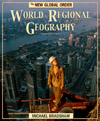 |  World Regional Geography: The New Global Order Update, 2/e Michael Bradshaw,
College of St. Mark and John
Northern Africa and Southwestern Asia
Chapter OutlineUse this outline to increase your understanding of the important characteristics
of North Africa and Southwest Asia. - In the Middle -- This
region is located at a globally significant junction of landmasses and cultures.
Two way interactions between this region and surrounding regions have had
great impact.
- Religions and Languages
- Religions -- This is
the Islamic heartland although other religions developed in the region before
Islam.
- Languages -- Arabic
is the principal language.
- Arab and Islamic Political
Movements -- With varying degrees of success, several organizations have
attempted to unify Arab and Islamic countries.
- World Issue: Islamic
Fundamentalism -- This movement varies in strength and questions Muslim involvement
with the Western world and in the world economy.
- Natural Environment
- Dry Climates and Desert
Vegetation -- Overall dryness means places that do have water are especially
important.
- Clashing Plates --
Tectonic plates have formed the varied topography.
- Major River Valleys
-- The Tigris-Euphrates and Nile river systems supply much needed water.
- Oil Resources -- In
spite of price fluctuations, huge reserves of the world's most used energy
source permit a continuous flow of revenue to some, but not all countries
of this region.
- Environmental Problems
-- Oil related pollution and salinization are concerns.
- North Africa -- Possessing
European connections, these countries are part of the Muslim world.
- Countries -- Algeria,
Libya, Morocco, and Tunisia make up this region.
- People -- Although
decreasing in some areas, population growth remains rapid and is becoming
more urban. French influence was important.
- Economic Development
-- Several problems like large amounts of international debt hinder further
economic growth. Manufacturing and tertiary activities are increasing.
- Nile Valley -- Water
flowing in the Nile River has been crucial for life since ancient times.
- Countries -- Egypt
and Sudan have similarities and contrasts.
- People -- Rapid population
growth puts pressure on the limited arable land. Egyptian civilization is
now Muslim and Arab.
- Economic Development
-- In contrast to Egypt, Sudan is isolated from the world economy. Significant
income coming from Egyptians and Sudanese working in the Persian Gulf area
has declined.
- Arab Southwest Asia --
Islam and oil production dominate this area.
- Countries -- Oil and
water resources vary from country to country.
- People -- The population
is located where water is available, urbanizing rapidly, and growing quickly.
Mesopotamia was an early civilization.
- Economic Development
-- Oil exports provide funds for development projects, but not every country
has oil and eventually the oil will run out. In response, countries attempt
to diversify their economies.
- Living in Syria -- Socialism
under the Baath party, ending ties with the Soviet Union, and deciding how
much to become part of the world economy are changing Syria.
- Israel, Gaza, and West
Bank -- Conflict between Israel and its neighbors has been recurring since
1948. Israel is a relatively successful homeland for five million Jews.
- People -- Migration
of Jews from Russia and elsewhere fuels population growth in Israel. Israel
is a special place for most of its people, but has increasing internal tensions.
Gaza and West Bank contain many Palestinians.
- Economic Development
-- Israel's economy is similar to a European economy being diversified in
manufacturing and services.
- Turkey and Iran -- These
countries differ from the rest of North Africa and Southwest Asia in several
ways.
- Countries -- Turkey
and Iran continue to be political and economic rivals.
- People -- Both countries
are populous and contain considerable ethnic diversity. The Byzantine Empire
in Turkey and the Persian Empire in Iran were historically significant.
- Economic Development
-- Iran uses oil and Turkey uses water resources to support their respective
economies. Manufacturing and services are more diversified in Turkey than
in Iran.
- Landscapes in North Africa
and Southwest Asia -- Urbanization has been rapid with many new town areas
growing around old sections. Oil has paid for much of the economic development
that has caused urban growth.
- Future Prospects -- Prospects
for this subregion depend on factors like the level of involvement in the
world economic system. The Gulf War of 1991 reflects the divisions that persist
within this region.
|
|



 2002 McGraw-Hill Higher Education
2002 McGraw-Hill Higher Education